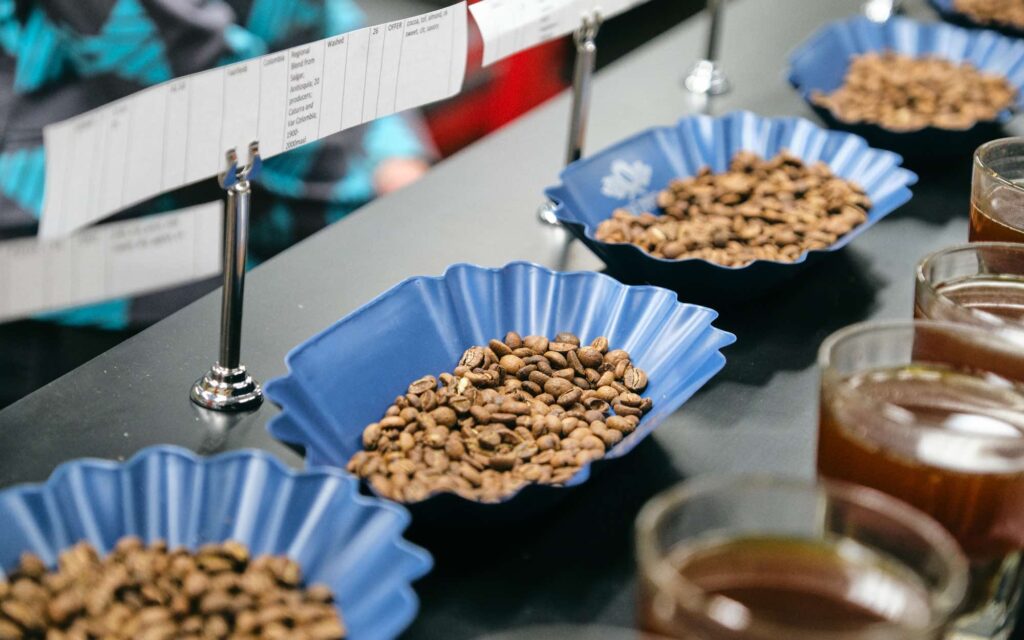How origin migration is impacting the coffee supply chain

Origin migration is impacting everyone across the coffee supply chain and will remain a threat to the next generation of coffee producers unless immediate action is taken.
When Olga Alvarado left her Honduran home and son at 18 years old to move to the United States, she did so with the intention to earn enough money to buy a coffee plot in Honduras and provide a better future for her son.
In an interview Alvarado shared with Fairtrade International, she said the situation when she left Honduras was “very difficult” because of low coffee prices.
Alvarado stayed in the US eight years to save enough money to buy six acres (about four hectares) of land. She returned to Honduras in 2015 and joined the Coaquil coffee cooperative in the Masaguara area. Today, Alvarado is one of the 760,000 smallholder coffee farmers that are part of Fairtrade.
“My hope for my children is to get them ahead, that they would be professionals, that they don’t migrate to another country,” Alvarado tells Fairtrade International. “[I] teach them what I am learning, so that in the future they can do what I am doing now.”
Alvarado’s case is one of thousands, with about half of the members of the Coaquil cooperative having previously migrated to the US.
According to the Migration Policy Institute, in 2022 there was a record-breaking 2.4 million migrant apprehensions at the United States-Mexico border, with 43 per cent coming from Guatemala, Honduras and El Salvador where coffee is a prominent export.
Significant arrivals were also felt by Brazilians, Ecuadorians, and Haitians, with arrivals representing a 37 per cent increase compared to 2021 figures.
“During this season’s harvest, Central America reported mass labour shortages, higher costs, and fleeing youth from coffee communities. Some cooperatives have seen 10 to 15 community members disappear in a matter of weeks, all of whom were former coffee pickers,” says Lauren Jones of the University of California, Berkeley, studying a bachelor of science in environmental economics and policy.
“While we may see short-term impacts on labour during harvest season, the drivers and resulting implications of migration on coffee are interconnected with climate change, food insecurity, low wages, and insufficient income. In addition, it is one of the main causes of next generation farmers leaving their communities.”
Jones says additional historic drivers of migration for coffee farming communities include poverty, violence, inequality, water insecurity, natural disasters, political instability, family ties in destination countries, and lack of access to work. In recent years however, climate change, the COVID-19 pandemic, and low coffee prices have contributed to worsened living and farming conditions.
The U.S. Department of Homeland Security, Instituto Hondureño de Café, says a drop in coffee prices from US$1.60 to US$1.40 would estimate a 22 per cent increase in migration in a non-coffee producing municipality and 120 per cent increase in migration in a coffee producing municipality. It also predicts a 5 per cent decrease in coffee prices would result in a further 14,400 more Honduran migrants, where currently one million people depend on coffee to sustain their livelihoods.
The National Institute of Migration in Honduras says approximately 400 people intersect irregular border crossings between Nicaragua and Honduras on a daily basis.
Due to a 10 per cent increase in droughts throughout Honduras, the Honduras Technical Unit of Food Security and Nutrition predicts migrant apprehensions will also increase by 90 per cent.
A Mixed Migrant Centre survey of 212 migrants in August 2020 responded that the pandemic had resulted in a lost income, reduced access to work, increased stress, lack of mobility and reduced access to basic goods.
Strategy and structure
Blanca María Castro, International Women’s Coffee Alliance (IWCA) Chapter Relations Manager says while the economic price challenges of coffee production are a significant contributor to harvest migration, it is not the primary cause.
“Receiving a good price for coffee without structure does not mean it will change the situation. Suppose that a small producer of one year, one crop, receives good money for their coffee, they won’t invest. They will most probably hire a coyote to bring their kids to the [United] States. If they can, they would do that immediately. They will use that money to move,” Castro says.
What the market needs to understand, Castro adds, is that the right economic structures need to be in place, with human development programs and projects that allow businesses to be sustainable.
“There needs to be a plan and structure where farmers can ensure not only their kids, but their grandkids, can follow the farming profession and take care of the land. It’s not a matter of buyers and the roasters paying more. Yes, that can be done. But we need to create awareness and say, ‘hey, this is a red flag, what’s going on?’ If the governments or entities are not really involved and not really putting their heads together and doing something about it, it won’t change. We need to raise our voices and make some noise. It’s not a matter of money. It’s about creating structure,” Castro says.
She notes that issue stems back to a lack of leadership, security, and structure in Central American governments, with drug trafficking difficult to control. Castro says the situation is not gender specific. Rather, it’s an issue impacting whole generations of families, and those countries directly near the United States.
“They are promised the American dream. The opportunities of work in the US are real. I’m in Texas right now. If I look out to the people on the street, I see people repairing roofs or doing work on the streets, most of them are Latinos,” Castro says.
The other type of prevalent immigration is that of producers moving from rural areas to urban areas, which is also affecting production.
“A lack of governmental structure is also involved in this scenario. What are they doing to entice kids to stay in the rural area and get the support they need for education and technical access? All they need is to really fall in love with their ancestor’s coffee, and not dream about being a lawyer or doctor, or impossible dreams,” Castro says.
“Coffee farming is so vulnerable. It can be wonderful one year, and messy the next. The biological behaviour of coffee plants has shown that one year could produce high yields of cherries, and the next it doesn’t, not to mention climate change effects.”
For Castro, all these factors equate to a reality she’s genuinely concerned about.
“We all depend on agriculture, and coffee brings a lot of money into the market, so I don’t know why Latin American governments are not investing and creating the structures and develop better programs for improving rural activities and making the agricultural sector better as a whole, not just for coffee,” she says.
Brazil Specialty Coffee Association Executive Director Vinicius Estrela says rural migration to urban environments in Brazil, is common, as is migration from the less developed north and northeast regions of the country to the more developed south and southeast regions.
“This does not affect only coffee, of course. Youth from coffee producing areas often move to larger cities seeking better opportunities,” Estrela says.
He adds that the impact of harvest migration is a sad reality for the lost potential of coffee varietals.
“When people abandon coffee for economic reasons, we lose much in terms of the diversity of terroirs that produce the various sensory profiles that captivate coffee lovers around the world,” Estrela says.
“Ultimately, responsibility lies with the consumer voting with his or her money for a sustainable, equitable supply chain to guarantee availability of high-quality coffees from diverse origins into the future.”
Thankfully, Estrela says the world’s largest producer of coffee has more registered coffee producers today, than ever before.
“According to the National Coffee Council, there are over 330,000 coffee farmers in the country, 78 per cent being small producers, and coffee is responsible for 8.4 million direct and indirect jobs in 1983 municipalities,” he says.
“That said, we are indeed concerned about the coffee producers of the future. The succession of coffee farms to the next generation is a frequent topic of discussion.”
What’s needed, Estrela says, is consumer education.
“Lack of attention or care at any point [in the coffee chain] can ruin everything. But it all starts with the hard work of the coffee producer in the fields. Without the producer, the rest of the value chain falls apart,” he says.
“Unless we can ensure that people can proudly say they are coffee producers in their regions, that it’s not just an economically viable activity, but rewarding, something their children want to carry on, we face a future in which coffee is overwhelmingly dominated by a few big players offering less diverse, less interesting coffees at higher prices.”
Outside of immigration movement is a rising market of business immigration into the US, according to Irina Batrakova, an attorney at The Batrakova Law Office in Portland and Miami.
“Since COVID-19 and change in administration overall [in the US], in the past three years we have seen an increase in business and investor immigration in general,” Batrakova says.
“Our clients are businesses and individual business people who often come to the US to open start-ups or new affiliate offices, trying to make a living in the US.
“They call [the US] a land of opportunities for a reason and probably it’s the ability to make a living here and succeed, as well as the quality of life.”
The Batrakova Law Office has represented many clients in the coffee industry in the past 18 years who want to immigrate to the US, most recently a Guatemalan coffee producer and roaster in Portland. On average, the fee for an individual going through the employment migration process can be upwards from US$8000, for either an E-2 treaty investor visa or an L-1A intracompany transferee visa.
“I’m originally myself from the former Soviet Union. I think my ability to empathise with the clients because I understand what the process is like, I’ve been through it myself, makes me passionate about immigration law. And of course, I love to strategise with businesses and individuals on their ability to come to the US and start their life here,” Batrakova says.
Hope and change will come
Before producers question leaving their farming communities, IWCA Colombia Executive Director Lina Maria Granados Uribe says empowerment, education and awareness is needed, especially for female producers who, over the country’s 57 years of conflict, have seen their husbands killed, kidnapped or disappear, forcing them to stay in fields and maintain coffee crops.
“That’s why 30 per cent of the coffee growers in Colombia are women. It’s not that common in other countries,” Uribe says.
“Already people from the FARC (Revolutionary Armed Forces of Colombia) and other violent parts of the country are focused on growing coffee, not cocaine. So for us as Colombians, coffee is a positive solution to our conflict.”
Uribe is a fourth-generation coffee producer in Quindío. She is the first in her family to speak English, obtain a Master of Business Administration, and “really believe” that coffee is more than the picking, harvesting, and selling of green beans.
Once Uribe finished her university degree in 2016, she returned to the Central Andes, far from the capital city of Bogota in Colombia where 50,000 people live. In Colombia, 95 per cent of coffee grown comes from small producers who own one to five hectares of coffee, with 5 per cent large roasters who make up 95 per cent of the country’s coffee production.
Of the cooperative Uribe is part of, only 10 per cent of 101,500 members are under 30, with the average age 65. If no action is taken to motivate the next generation, Uribe says the cooperative will disappear in 20 years’ time. As such, it was always her intention to stay in the coffee fields and use her education to help her community. Uribe and IWCA Vice President Ana Maria Donneys started the IWCA Colombia Chapter, and begun working with to empower women to stay in the coffee fields.
“Women are perfectly capable of running a coffee farm, and coffee can open doors and opportunities,” Uribe says.
One of the first projects Uribe undertook on her return was to find direct trade relationships for Colombian coffee due to the number of farmers who struggle with free market prices where “the prices are going nowhere”.
“We are working on having direct relationships with the consumer. It’s the only thing that can help us to stay in their business,” she says.
“At this moment, our numbers are in red because picking and operational costs are more expensive, and market prices are going down. There will be challenging times over the next two years, however my dad told me the other day, ‘this is not the first time I’ve had hard times, but I love my job.’”
Like Castro, Uribe says the solution to reduce producer migration is not about increasing coffee prices or having consumers pay more. It’s about helping young people fall in love with the business of coffee, and ensuring producers and consumers are staying close to one another.
“My purpose is to be the bridge between the consumers in the consuming countries and the producers here so that we can get a ‘bigger slice of the cake’ and not see it taken by the middleman. Our main goal is to give opportunities to small and medium-sized producers to go direct to coffee shops, little roasters, and for people in consuming countries to know our history, our families, and all the effort and people involved behind a cup of coffee. We have to start being conscious about the people behind it, because consumers really do have the power in their hands when they make their buying decision,” Uribe says.
In the five or so years since the IWCA Colombia chapter started, Uribe says she’s amazed at the change she’s witnessing in her producing region. More women are involved in production with their families, promoting themselves, making agreements, becoming baristas and Q graders, and even requesting English classes for the rural town to better connect with the world.
“We are planting a little seed for people to measure their actions and success to help improve their lives. Coffee has to be a trap for young people to stay in the fields. They need to know they are part of a global community, that they belong to something, and coffee can open the doors to that sense of belonging,” she says.
Uribe is under no pretention that the challenges ahead are large. But when people question why she stays farming, amongst the mosquitos, rain and daily obstacles, passion overrides.
“I am really proud to tell people that my family are coffee growers, and that I am a grower myself,” she says. “When I become a mum one day, I will teach the same love for coffee as the generations of my family’s coffee farmers have to me, because this is how we preserve the profession.”
This article was first published in the September/October 2023 edition of Global Coffee Report. Read more HERE.
The post How origin migration is impacting the coffee supply chain appeared first on Global Coffee Report.





Responses